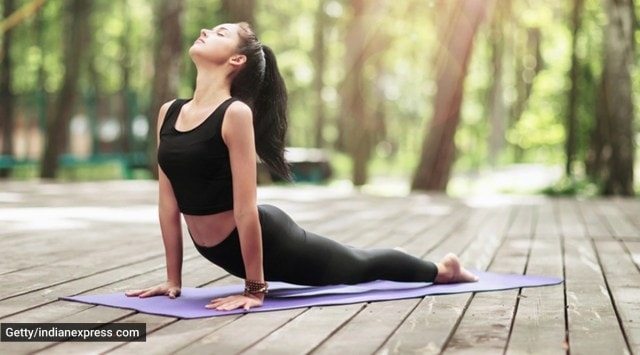- India
- International
If you have pain during sexual intercourse, try these pelvic floor exercises
Pelvic muscles can get weak due to pregnancy, childbirth, obesity, or normal body ageing, according to Nidhi Sharma, a fitness coach
 A cold shower post workout helps in recovery (Source: Getty Images/Thinkstock)
A cold shower post workout helps in recovery (Source: Getty Images/Thinkstock)Workouts benefit overall health, both mental and physical. But there are some specific exercises that focus on exclusive body parts or provide relief from certain conditions. As such, if you are looking for exercises to strengthen your pelvic floor muscles — a group of muscles found on the floor (the base) of the body at the bottom of the torso, you are at the right place. These muscles support the bladder, urethra, vagina, uterus, bowel (large intestine), rectum, and anus, and help support various day-to-day activities including urination.
How do you know if you have a weak pelvic floor?
Some of the symptoms of weak pelvic muscles are leakage of urine while sneezing, coughing, lower back pain, and pain during sexual intercourse. “Your pelvic muscles can get weak due to pregnancy, childbirth, obesity, or normal body ageing,” yoga practitioner and fitness coach Nidhi Sharma wrote on Instagram, adding, “weak pelvic impacts your quality of life, and extreme weakness might give rise to serious medical conditions.”
“These are one of the most important muscles and it’s super important to work on their strengthening,” Dr Nidhi further wrote as she demonstrated a few Kegel exercises that can help.
View this post on Instagram
“Core stability and strength are critical for every activity we do in our daily lives because these muscles distribute and transmit forces between the upper and lower limbs,” Varun Rattan, co-founder, The Body Science Academy, Noida told indianexpress.com.
*Hip Adductors (squeezing a ball between knees)

Hip adductor muscles are located on the inside of each thigh, above the knee and below the groin. There are five hip adductors situated in the medial section of the leg. These muscles are adductor longus, adductor brevis, adductor magnus, gracilis, and pectineus, described Rattan. “Squeezing a ball between the knees is perhaps one of the most convenient exercises to train hip adductor muscles safely,” said Rattan.
*Pelvic tilt
Pelvic tilting is a movement that we do when standing, walking, or even while sitting. It is not necessarily an exercise in the traditional sense of the word but more of a natural body movement that most people don’t think about. Controlled pelvic tilting works the muscles of the pelvic floor, rectus abdominis, obliques, hip flexors, and low back. Pelvic floor strengthening can help women who experience stress urinary incontinence or any other type of leakage from their bladder because these muscles keep in urine and faeces, explained Rattan.
*Bridges
Unlike other challenging exercises like squats or lunges, the hip bridge looks and sounds a bit too easy to be effective. “However, this low impact workout can help you tone your glutes and thighs with just a small space and only your bodyweight as resistance. The hip bridge exercise can prevent low back pain and improve poor posture caused by overactive lumbar muscles especially in those who spend a lot of time sitting at a desk,” said Rattan, adding one can increase the difficulty of this move by lifting one leg and even by placing weights above the pelvis.
*Leg raises
A strong and stable core is essential for everyday activities and athletic performance. It also looks great when you have a six pack. “Leg raises are an excellent way to strengthen your ‘six pack muscles’ (rectus abdominis) as well as obliques, which are located on either side of the rib cage and assist with stabilisation. If regular crunches don’t feel like enough of a challenge, try adding a few sets of leg raises or another variation into your routine,” said Rattan.
*Reverse Plank
It is a plank variation that targets the same core muscles as regular plank, but also the posterior chain muscles like back, rear deltoids, and glutes. Reverse planks are essentially the opposite of a traditional plank. Instead of resting on your forearms, you lift your entire body up with just your heels and palms (or elbows) touching the floor. “This exercise is slightly difficult to master, but it’s worth getting familiar with because it can help you advance your standard planks faster than if you just stuck to the basic version,” said Rattan.
*Bird Dog
The bird dog exercise helps strengthen and stabilise the erector spinae, rectus abdominis, and gluteal muscles. “These muscles help keep the body in correct alignment and provide stability. Individuals with low back problems may benefit from this exercise,” Rattan described.
By learning to contract your abdominals and keeping your back neutral while moving the limbs, you will be able to move more easily and perform athletic activities more efficiently. “Start with 3-4 sets of each with (15-20 reps),” added Sharma.
📣 For more lifestyle news, follow us on Instagram | Twitter | Facebook and don’t miss out on the latest updates!
More Lifestyle
Apr 25: Latest News
- 01
- 02
- 03
- 04
- 05



























